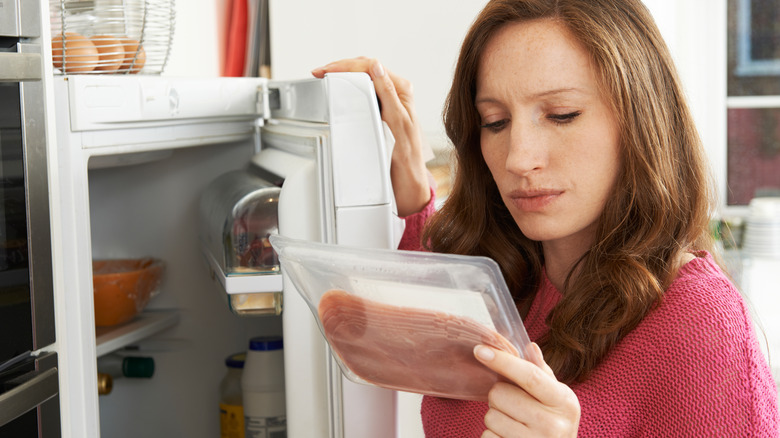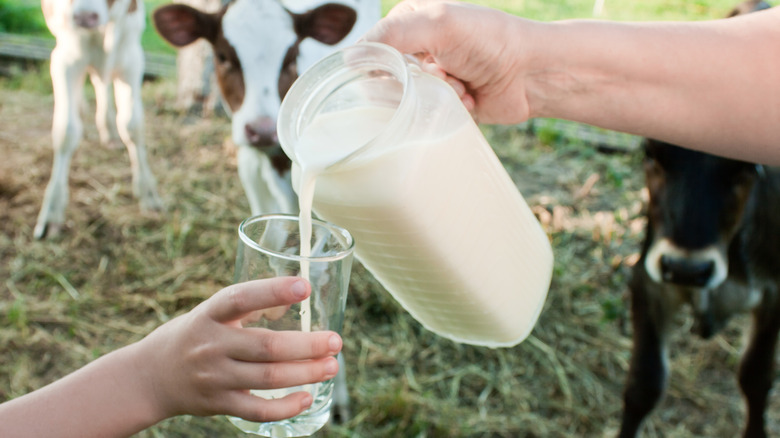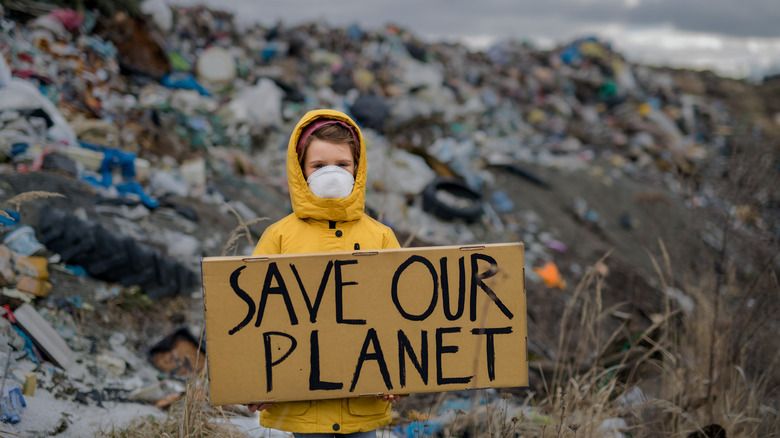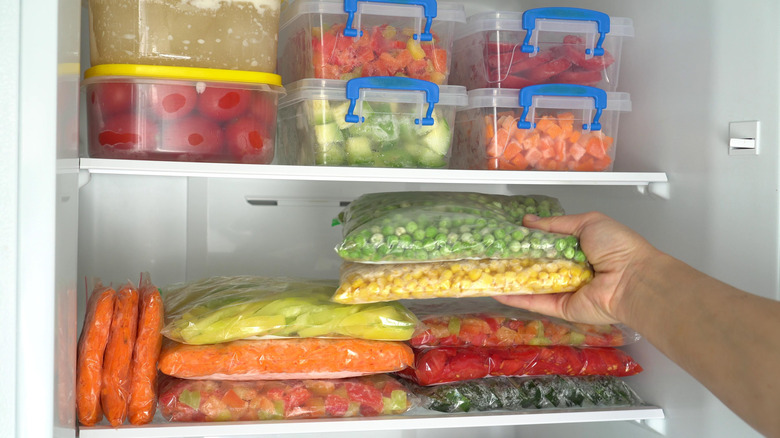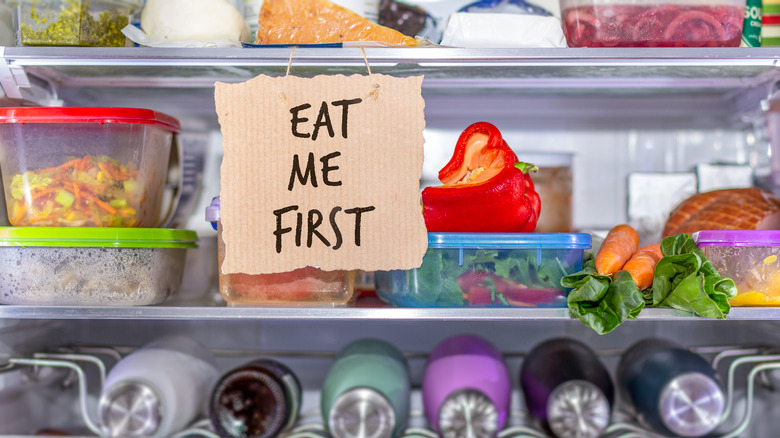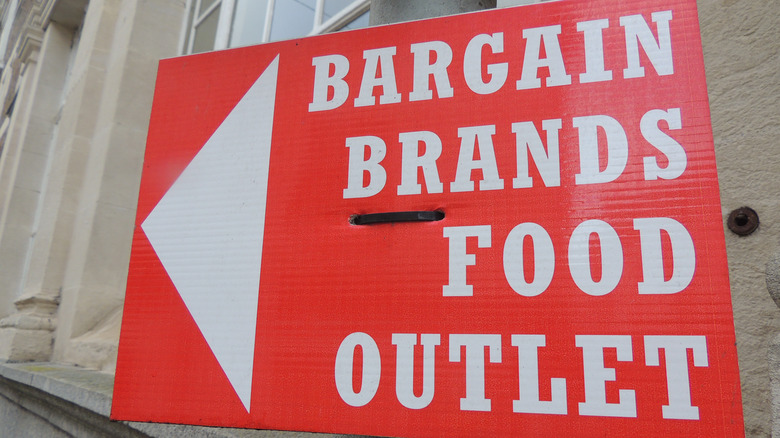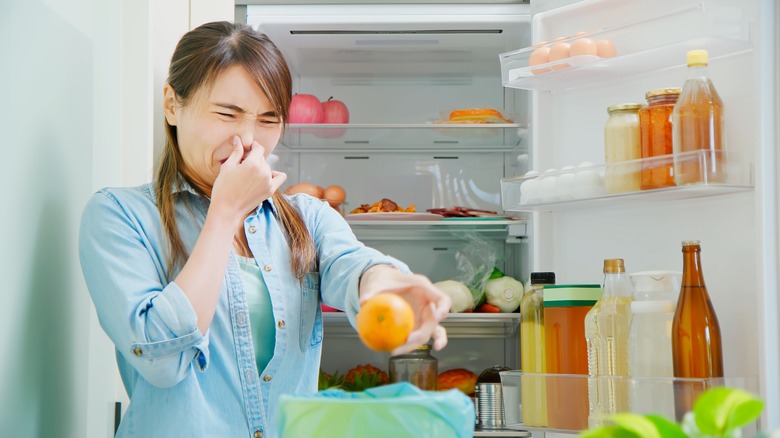Best By Dates On Food Explained
Getting ready to toss perishable foods like eggs, dairy products, and meat because they're past the "best by" or "use by" date on the package? Well, we'd like you to step away from that trash can — because "best by" and "use by" dates have little relation to the safety of the product (via Science Alert).
Except for dates on baby formula, "best by" dates aren't regulated by the federal government. Nutrition and ingredient information on packaged food is regulated, and has been since 1938. But "best by" dates (and variations on that wording) are determined by food producers — and the dates usually indicate the manufacturer's best guess at when the food will taste best and be the freshest, according to Consumer Reports.
What's more, many food producers set the dates on foods conservatively, so the products are sure to be top quality when consumed. If you understand this about date stamping, you'll probably feel safer about eating foods that are past their "best by" dates, and may not even notice any decline in their flavor or quality.
Sadly, 90% of Americans don't understand the dates on foods, according to the Natural Resources Defense Council (via Consumer Reports). As a result, it's estimated that the average American throws out nearly 1 pound of food every day — food that most likely is still safe to eat or freeze. Because confusion and waste are rampant, let's dive deeper into the mythology of the notorious expiration date.
Legend has it that mobsters Al or Ralph Capone originated expiration dates
According to Smithsonian Magazine, expiration dates may have first appeared in the 1930s after a member of gangster Al Capone's family got sick from drinking aged-beyond-perfect milk. The legend goes on to say that his experience with bad milk inspired Al Capone to get into the milk processing business himself and lobby the Chicago City Council to require visible date stamps on cartons of milk.
Another version of the myth claims that Al Capone's brother Ralph led the mobsters' leap into food safety after the son of a man he knew got sick from spoiled milk (via HuffPost). But HuffPost attempted to confirm this story with the U.S. Food and Drug Administration (FDA), the U.S. Department of Agriculture (USDA), and a milk safety expert at Cornell University, to no avail. But Ralph Capone's granddaughter sticks with the claim and says Ralph was nicknamed "Bottles" for his milk safety efforts.
Date stamping on foods other than milk didn't begin in the United States until the 1970s, after large swaths of the population had moved to cities and no longer had close contact with sources of the food they consumed. They wanted food manufacturers to assure them that the foods they were eating were fresh — and manufacturers' response was the piecemeal, patchwork, and mostly unregulated "best by" dates we see on foods today.
How to make sense of common date-stamping phrases on food
Because date stamping on most food packages isn't required or regulated, there's no standardization, explains the USDA. But commonly used phrases are "sell by," "best by," "best if used before," "use by," and "freeze by."
The "sell by" date is not directed toward consumers. It just tells the store's staff how long to display the product. "Best by," "nest if used before," and "use by" dates tell consumers the date the product will be at its peak quality and will taste the best. It's not the date when the product will no longer be safe and nutritious to eat "except for when used on infant formula" (via USDA). And the "freeze by" date is also related to the "peak quality" of the food, not safety.
To minimize consumers' confusion and cut down on food waste, the USDA's Food Safety and Inspection Service recommends food producers and retailers standardize date stamping by consistently using the words "best if used by." Research shows that consumers tend to understand the meaning of that phrase better than other options.
A seven-digit Julian code also may be stamped beside the "best by" date on foods. According to SunRidge Farms, "The first 3 digits tell you on what day of the year the bag or box was produced." The year the product was packaged is indicated by the next two digits, and the final two digits are the manufacturer's lot number. For example "the code '0152243' means that it was packaged on the 15th day of the year 2022 (January 15, 2022)."
Baby formula is one food where use by dates matter
While you can and should take most date stamps on food with a grain of salt, baby formula is a different matter. It's the only food where date stamping is actually required by the FDA, per the USDA. Never use formula after the "use by" date on the container, explains the Centers for Disease Control and Prevention (CDC). Unopened containers should be stored indoors in a cool, dry place, and once a container is opened, keep the lid tightly sealed and the container in a cool, dry place — not the refrigerator.
The CDC also has other safety tips related to infant formula. For example, when you open a new container of formula, write the date on the label. Then check the date stamp on the container to see how soon the formula needs to be used. "Most infant formulas need to be used within 1 month of opening the container" (per CDC).
Once you've prepared the formula, remember that it can spoil if left at room temperature. If you prepare it but don't need it immediately, you can keep it in the fridge for up to 24 hours. If left at room temperature, it should be used within two hours. And if there's any formula left in the bottle after you've fed your baby, throw it out. The baby's saliva mixed with the formula can create a haven for bacteria.
Huge food waste and environmental problems can be linked to best by dates
Research abounds related to the waste associated with "best by" dates on food. A survey done by the Harvard Food Law and Policy Clinic found that a third of respondents usually or always throw away food after the date stamped on products, and 84% trash food occasionally (via The Washington Post).
It's estimated that as much as 35% of food goes uneaten in the United States, and the United Nations estimates that 17% of global food production is wasted every year (via AP News). Tossing food that is perfectly safe based on "best by" dates means that land, water, and labor is wasted on food production, and that greenhouse gas emissions rise because unwanted food is piling up in our landfills.
In the United Kingdom, large food chains have removed "best before" date stamps from prepackaged fruits and vegetables, and the European Union is expected to announce big changes to labeling laws by 2023. They may even eliminate date stamping entirely. A less ambitious change is afoot in the United States that would standardize date stamping on food to minimize consumer confusion and educate shoppers about food waste.
A storage-guide site and app provides an abundance of food quality information
FoodSafety.gov offers a FoodKeeper site with a plethora of information on storing specific foods and beverages, and how long you can keep them stored — open, unopened, refrigerated or not. Please note, however, that its focus is on quality and freshness, not on whether the food is safe to eat or not.
Developed by the USDA's Food Safety and Inspection Service with the Food Marketing Institute and Cornell University, the site, which is also available via an app for Android and Apple devices, covers everything from baby food to vegetarian proteins, and from deli foods to shelf-stable goods.
Take high-acid canned goods such as sauerkraut, pickles, and tomato soup, as examples. FoodKeeper explains they're good for 12 to 18 months if stored, unopened, in your pantry, but eating them is ill-advised if you open them and then store them in your pantry.
Fresh pasta can be refrigerated for one to two days for best freshness and quality, or frozen for two months. Coconut water is fine if stored unopened in your pantry for 12 months, or refrigerated for one to two days after opening. And balsamic vinegar retains its freshness and quality for three to five years in your pantry, or 18 months when refrigerated after opening.
You don't need to pitch eggs after the sell by date
You should buy eggs before the "sell by" date on the carton, but they should be safe to eat for three to five weeks past their "sell by" or "expiration" date, notes the USDA. There are some conditions. You have to take the eggs right home from the store, keep them in their carton, and put them in the coolest part of your refrigerator where it's at least 40 degrees Fahrenheit. In other words, not on the door of your fridge.
If you're uncertain about whether eggs are still good or not, Cooking Light proposes some tests you can perform. First, a couple fairly obvious ones: If you see slime, mold, or a powdery residue on the shell, toss it. And if it smells rotten, toss it. You can also shake it while you hold it up to your ear. If you hear sloshing, that means the yolk has "gone thin and watery" — not a good sign. Or you can try a water test and, "Gently release the egg into the water. If the egg sinks, it's still good. If it floats, it's old."
But even an old egg can be safe to eat, according to the USDA, so don't toss it immediately. "An egg can float in water when its air cell has enlarged sufficiently to keep it buoyant. This means the egg is old, but it may be perfectly safe to use." Instead, crack it into a bowl and see if it has an unpleasant odor or an unusual appearance. If it does, it's time to toss it.
Freezing is a great way to keep foods safe and tasty
Once you properly freeze a wide variety of foods, they're safe for weeks and months past their "best by" date stamps, explains Taste of Home. What does "properly" mean? Your freezer should be kept at 0 degrees Fahrenheit to keep foods thoroughly frozen and well preserved. Use a thermometer to monitor your freezer's temperature, and don't place hot or warm foods in the freezer. They can cause other foods to start thawing.
Meat and poultry can be safely frozen in its original packaging if used within about two months (via University of Illinois Extension). If you plan to store it longer, just overwrap the original packaging with freezer wrap, a freezer zip-lock bag, or heavy-duty foil. Using a home vacuum packager is also a good option. The trick is to seal out as much air as possible because oxygen in the air contributes to freezer burn. And, while freezer burn doesn't make foods unsafe, it causes them to dry out and can alter their flavor.
Of course, some foods freeze better than others, according to The New York Times. Dairy products such as milk, cream cheese, cream, sour cream, and yogurt are all safe to freeze. Their texture may be slightly altered when defrosted, however, so you may want to save them for cooking or baking. Fruit falls in the same category — safe to freeze but best used for smoothies or cooking.
Tips for keeping refrigerated foods safe beyond best by dates
There's plenty you can do to keep refrigerated foods safe (via University of Washington Medicine). Start by keeping your fridge at 40 degrees Fahrenheit or cooler, and pop foods that need refrigeration inside immediately when you get home from the store. Put the newest food at the back of the appliance and the older items at the front, so you'll be more likely to use the oldest ones first. Cover all containers, and wipe up any spills so they don't spread bacteria.
The Academy of Nutrition and Dietetics offers additional tips. Leave foods in their original packages unless the package is torn; in that case, repackage and seal it well so the food doesn't lose moisture or absorb odors from other foods. Don't keep your refrigerator door open too long, and avoid overloading the fridge so the cold air can circulate easily. Also, if you find any moldy foods, toss both the food and the bag or wrapper the food is in, and check any foods that were touching the moldy item — especially fruits and vegetables, where mold can spread quickly.
You can donate food that is past its expiration date
Many large food banks throughout the country encourage the donation of past-dated foods, and have dieticians on staff who evaluate the donated foods for safety and nutrition (via Hunter College New York City Food Policy Center). Smaller food banks that don't have dieticians may not accept past-dated foods, to be on the safe side. Federal and state legislation even protects people who donate food from being held accountable if someone gets sick from eating the donated food. You're not liable, as long as you donated the food in good faith.
Urban Gleaners is one example of a nonprofit organization that welcomes wholesome, edible food that has passed its "best by" date but is still good. The organization doesn't accept canned goods that are heavily dented or expired by more than four years, or shelf-stable foods like flour or rice that have been opened.
By collaborating with food manufacturers, Ozarks Food Harvest knows which foods are safe well past their expiration dates. Dry cereal gets a six-month extension, they say, and dry pasta made with egg gets a two-year extension.
Before donating any food, look it over and decide whether you would eat it yourself. If you wouldn't, toss it.
Tips for shopping at surplus or bargain food outlets
By now you're probably clear on the fact that "best by" date stamps are a measure of quality and flavor, not safety. So, when shopping at surplus food outlets, focus instead on the package itself (via the FDA). Is there liquid leaking out? If so, there's an opening in the package somewhere, which means bacteria is getting in. The same goes for packaging that has been resealed or repaired. Food should be sold in its original packaging.
Common sense should come in handy when selecting canned goods at bargain food outlets. If you see rust along the seams of the can, or the can looks swollen or bulging or dented, its contents could be unsafe. And if you have food allergies or other dietary restrictions, be sure to notice if labels on food packages appear to be changed, because new labels may not properly list the ingredients or lot numbers.
With fresh food, the "look and smell" test may be the best way to rule out unsafe foods. If it looks or smells bad, don't buy it. The look of the store itself can give you clues, too. Does it look clean? Do you see any rodents or bugs? If you're concerned about cleanliness, check with your state or local health department to find out if the store has been found in violation of any safe food handling and storage practices.
Trust your eyes and nose before following best by dates
In the absence of clear cut, understandable date stamping on foods, ScienceAlert suggests that using your own observation skills may be the best way to determine whether food is safe to eat. What should you look for? Molds and fuzzy growth on solid foods is usually a sign that it's time to throw out the food, explains The Conversation, and liquids that smell bad, look cloudy, or have clumps in them are also ready to toss.
Caution is still in order when it comes to foods the FDA considers potentially hazardous — sliced tomatoes, chicken, and milk, for example — because they contain moisture and an abundance of nutrients that allow microbes to flourish in them. However, date stamping on these foods is no different than dates on more stable foods, so "better safe than sorry" may be the way to go on these specific foods.
Some dense foods, like hard cheeses, may be an exception to the "toss if moldy" rule (via NBC Philadelphia). Because density makes it difficult for mold to spread, it's okay to cut a chunk out of the food that skirts the moldy patch by 1 inch and eat the rest. The USDA offers a chart to help you determine whether other moldy foods are safe to eat.

